I’ve just done my ISEB Business Analysis Foundation exam and passed, I had the excellent book from Debra Paul, Donald Yeates and James Cadle. If you’re thinking of doing this exam I recommend you buy the book! Don’t take my revision notes as your only source of information for passing your exam, I make no warranties or guarantees what so ever.
A link to the Business Analysis Book. Also click here for a syllabus document from the BCS. (Links working as of 25 July 2011.)
1 – Introduction
A couple of points, if you’re familiar with any of the list below you should be more than fine 🙂
- Business Analysis (ie PESTLE and Porter)
- Project Management (ie Prince2 and PMP)
- Modelling Techniques (ie UML, entity and class)
- Software Development Approaches (ie Waterfall and Scrum)
- Financial & Business Documentation (ie NPV, ROI & Prince2)
- Business Assurance (ie ISO 27001)
If you have a business degree of some sort you’ll be great.
2 – Competencies of a Business Analysis
Behavioural Skills & Personal Qualities
Communication
- Poor communication is often cited as a reason IT project fail
- Communicate with business in business language not technical
- Adjust communication for who you’re speaking to, ie MD, shop floor, etc
Relationship Building
- People need to trust you and impart knowledge to you, you may need their help
- Take interest in other people
Influencing
- Identify stakeholders and influence each differently as to where they stand on the proposal and how decision making takes place
- Especially required if conclusion is at odds with preconceived ideas and against hidden agendas
- May need to take the middle ground between different groups
Team Working
- Analysis work often takes place around multiple parts of the business
- Understand your place in the team and the motivations of your colleagues
Political Awareness
- Internal and external
- “The way things get done round here”
Analytical Skills & Critical Thinking
- Not settling for the obvious or established thinking, root cause and holistic thinking
- Digging deeper until a true situation is uncovered
- Why? What? Where? How? When?
Attention to Detail
- Plenty of data and information in every aspect
Problem Solving
- A mindset that problems can be approached and solved
Leadership
- Develop a vision, taking ownership and ensure actions to implement vision are realised
Self Belief
- Confidence in yourself, in quality of your analysis, helps influence
Business Knowledge
- Finance & the Economy
- Understanding of P&L, ROI, NPV and balance sheets
- Business Case Development
- Must be able to literate the financial costs & benefits of a analysis and Understand the above
- Understand technical costs & benefits
Domain Knowledge
- Understanding of the business and the industry it operates in
- Helps to know what is acceptable and what isn’t
Subject Matter Expertise
- Ie Strategy. Domains (ie Banks), etc
Principals of IT
- Don’t have to be an IT expert
- Level of knowledge will depend on subject
- Systems frameworks (ie agile, waterfall, UML, supplier management, etc)
Organisation Structures & Design
- How to centralise a process or improve customer service
- Supplier Management
- Contractual agreements, Time & Materials, Fixed Price Delivery, Risk & Reward
Techniques
- Project Management, Ie PMP, Prince2, ISEB PM,
- Strategy Analysis
3 – Strategy Analysis
The Context for Strategy
- Strategy exists because there is uncertainty and it helps to moderate this uncertainty
- Organisations are doing everything they can to help increase flexibility and responsiveness
- BAs must be able to understand the strategy in terms of global uncertainty
What is Strategy
- The direction of the business, otherwise known as goal or mission
- A timeframe in which to operate, usually long term
- The organisational resources available
- The markets and environment and how the company applied itself
- The management and implementation of change
- Corporate Strategy – Overall purpose of business, shaped by investors, governments
- Business Unit Strategy – Translation of the above into operational steps
- Operational Strategy – Using BUS and Corporate strategy to deliver
Strategy provides us with:
- Focus for the organisation and understanding of the reasons behind actions
- Framework for allocation of resources (inc money)
- Guides where innovation is needed
- Performance measures (have we achieved our goal?)
- External communication (this is what we do)
Strategy Development
Where does strategy come from?
- Individuals/Entrepreneurial (ie Richard Branson or flashes of inspiration that business agree on)
- Decentralised & Empowered Organisations (managers after analysis)
- Planning (what do we want to do and where do we want to be? How do we position ourselves to realise the benefits?)
Strategy can and does change (ie a crisis or a change of leadership)
Collective knowledge of managers and business can create a strategy
‘Garbage can strategy’ – many ideas thrown in, and a process used to pick out good ideas, in other words brainstorming
External Environment Analysis
PESTLE Analysis
(otherwise known as PESTEL, PEST, STEEP, STEEPL) can be used to identify key external stimulus to the organisation
- Political (ie trade unions)
- Economic (ie competitors, interest rates, unemployment)
- Sociocultural (ie demographics, social mobility, working practices)
- Technological (ie reduction of barriers to entry)
- Legal (ie regulation, employment law)
- Environmental (ie waste, ‘green’)
Porters 5 Forces
- Bargaining Power of Suppliers (ie lots of companies to buy from or not, difficulty in changing suppliers)
- Bargaining Power of Buyers (ie how big is the market? Is it saturated? Can they change easily?)
- Threat from Substitute Products (ie VHS to DVD to Blueray, can we do without?)
- Threat of new Entrants (ie is it expensive to set up as a competitor? Can consumers switch easily?)
- Industry Competitors – Rivalry Among Firms (ie how many companies are there doing what we do?)
Internal Environment Analysis
Strategy needs to take into account the organisational capability
MOST Analysis
- Mission – Statement declaring what the organisation wants to achieve
- Objective – Goals to realise the mission
- Strategy – The approach to be taken to complete the objectives
- Tactics – The detailed steps required from the strategy
Resource Audit
- Physical (buildings, plant, equipment, land, etc)
- Financial (stability, balance sheet, turnover, etc)
- Human (expertise, number, commitment, etc)
- (Intangible) Know-how (organisational knowledge, patents, trademarks, etc)
- (Intangible) Reputation (brand recognition, loyalty, or not, etc)
Portfolio (of products) Analysis – Boston Box
SWOT Analysis (bringing all the analysis together)
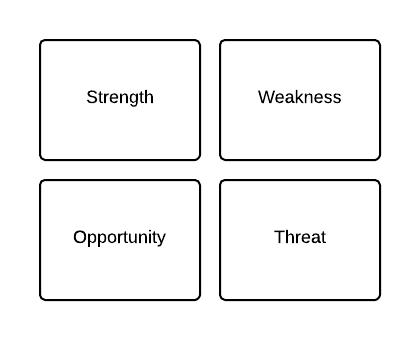
Internal, External, Positive, Negative
- Strengths (ie strong product branding, customer loyalty, etc)
- Weaknesses (ie expensive manufacturing compared to competitors, high product returns, etc)
- Opportunities (ie new markets opening for products)
- Threats (ie low barriers of entry to our market, product isn’t green)
Implementing Strategy
Implementation of strategy implies change, and change implies risk (see Part 14)
Contextual Issues
- Time (ie how quickly)
- Scope (ie big or little change)
- Capability (ie how does business and markets react to change?)
- Readiness (ie is the organisation and market ready for the change?)
- Strategic Leadership (ie who leads the change, doesn’t have to be the top management, a leader and celebrates success)
McKinsey 7-S Model
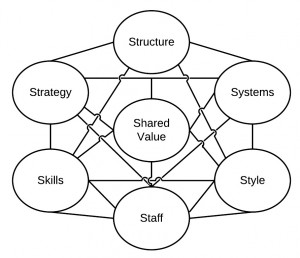
- (Hard Component) Structure (ie how it will change)
- (Hard Component) Strategy
- (Hard Component) Systems (ie how they will support)
- (Soft Component) Shared Value (ie guiding concepts of organisation)
- (Soft Component) Style (ie how things get done round here)
- (Soft Component) Staff (ie how they will react to change)
- (Soft Component) Skills (ie organisational knowledge and staff talent)
Balanced Business Scorecard
Less emphasis on financials as a measure of success than other methods
4 – The Business Analysis Process Model
An overview framework model is used to place business analysis stages in context in order to assist with deciding on best course of action
BAs must take a holistic approach to the business and provide a thoughtful and creative approach to solutions
Challenge is to offer something that is suitably flexible that will improve the situation
Isaken & Treffingers Creative Problem Solving Model (like a waterfall)
- Mess finding (ie statement of the situation, informally identify the boundaries for the problem, use rich pictures or mind maps)
- Data Finding (ie analysing the options, concerns in the previous stage and obtaining starting data, see part 5)
- Problem Finding (ie the root issue(s), find the right problem not the easy one)
- Idea Finding (ie ideas and criteria that may solve the problem, use creative thinking or brainstorming)
- Solution Finding (ie focus on ideas from previous step to provide solutions)
- Acceptance Finding (ie managing the implementation of the solution, use business case and implementation of change)
The Process Model
Investigation Situation
- See Part 5
- Choose most appropriate methods dependant on level of detail required, ie stakeholder analysis, rich picture or prototyping
- Study background material, initial investigation with stakeholders, document outcomes
- Produce minutes, rich pictures, mind maps, list of issues, business needs log
- Techniques, questionnaires, sampling and above
- Considering Perspectives
5 – Investigation Techniques
Prior Research
Study the Company Website
- Quickest and simplest way to get a view of the organisation, how it brands itself and how it wants to be perceived
- Branding is very important message
- Customer reviews and the like
- How it views quality/cost
Company Reports
- Statutory documents (ie companies house & shareholder documents)
Company procedures, manuals & documentation
- Study current systems (perhaps analyse them)
- It gives the expected ‘what is’ (may be different from what actually happens)
Organisation Chat
- Reporting lines, hierarchy, flat or tall, etc
Investigation Techniques
Interactive part of the analysis
- Qualitative – in words
- Quantitative – in numbers
Qualitative Approaches
Interviews
For making initial contact with stakeholders
Building rapport
Acquiring the information about the business situation
One to one interview is the norm to focus on the individual
Investigate the following three areas:
- Current functions that need to be covered
- Problems with the current situation
- New features to be implemented
Advantages of Interviews:
- Understand viewpoints
- Investigate new areas
- Collect documentation
- Appreciation of political factors
- Environmental
Disadvantages of Interviews
- Expensive and time consuming
- Can create follow up actions (ie documentation requests)
“Who? Why? What? When? Where?” – Framework
- Who? – STOP model (as a pyramid), Strategic management level, Tactical middle management, OPerational level
- Why? – Why a particular interviewee is going to be selected, from obtaining business information to good stakeholder management
- What? – Considering the information that may be useful and explored
- When? – Considering the venue, timing and duration of the interview, try limiting interviews to an hour
- Where? – Consider own territory, observing working and sources to relevant information
Conducting the Interview
Prior to Interview
Make sure attendees have agenda
Open – Introductions & Scene Setting – 10% of Time
Make sure analyst and interviewee understand reason for meeting and project and put the interview in context
Body of the Interview – Questions & Answers – 80% of Time
Main area where facts and issues are uncovered, make sure the context to the interview and interviewee is understood
Make sure you take notes during the interview, and if necessary provide & create diagrams
Close – Summarise Next Steps – 10% of Time
Summarise points made and actions agreed
What happens next? Ask how they would prefer future contact?
Following Up
Read through notes, and write up. Then good practice to submit to interviewee
Observation
- Useful in obtaining information about business environment and work practices
- Make sure those being observed know the purpose of the observation
- Useful if perceived situation differs from the actual processes or a lack of understanding as to what is going on
- You will get a much better idea of the issues facing the business and it’s users
- Will help to devise workable solutions based on observation
- Runs the risk of being shown what is the official procedure as opposed to how it is done
Protocol Analysis
- Asking people to perform a task and describe each step they take, an excellent way to obtain tacit knowledge
- “Performing & Describing”
Shadowing
- Following a person for one or two days to find out what a particular role involves
- Important and good to build rapport
- Gives excellent context from interviews
Workshops
A collaborative forum where issues can be discussed
- Especially useful if time and budget issues are constraining the project
- Gains a broad view of the area under investigation
- Much quicker that individual meetings
- With collaboration stakeholders are more likely to buy in to the process
- Gain consensus
- But, time consuming to run and organise
- But, individual participants can rule the forum
- But, difficult to get required level of authority in one place
Preparing for Workshop
- What do you want to achieve? Try breaking down requirements into individual components
- Make sure attendees are invited, and representative of what you are trying to achieve
- Interests of participants are understood, and their viewpoints considered
- Structure of the workshop needs to obtain the results you need and the people present (think STOP and social issues)
- Arrange a suitable venue, neutral issue vs workplace issues
Workshop Techniques
- Brainstorming – Ideas and evaluation are conducted simultaneously and points recorded usually on a flip chart of similar device
- Round Robin – Participants are asked for their opinions in turn
- Brain Writing – Participants write down their thoughts and then these are collected
- Stepwise Reinforcement – Where we take a statement and keep asking “Why?” until we get back to the heart of the situation
- Break Out Groups – Smaller groups work on the issue then present findings
Facilitating the Workshop
- Discuss the objectives and try to obtain buy in, try using the business sponsor to open the discussion
- Ensure that the conversation and discussion does not go too off track from the objectives
- Keep notes of key points of the discussions, make sure non-verbal clues can be recorded
- Summarise all the points made for further buy in and follow up by sending participants the information
Focus Groups
- Bring together a group of people with a common interest to discuss a topic
- Usually used for marketing, ie why a group of customers are unhappy with a certain service
- Scenarios
- Telling a story of a task or transaction, helps when a user who is uncertain about what is needed from a new business process or system to visualise it more clearly
- Key strength is that they provide a framework for discovering exceptional situations that require alternative paths to be followed
Advantages
- They require the user to include each step and transition between the steps, and as a result remove the opportunity for omissions
- Ensures there are no taken for granted steps
- All possibilities should be explored
- All steps must be marked as “true” to progress to the next one
- Can feed into a UML diagram
Scenario Model
Useful for developing prototypes, used for preparing acceptance tasks
Identify Task or Interaction –> Identify Steps & Sequence –> Define Control Conditions –> Identify Exceptional Situations
Prototyping
- Important technique for eliciting, analysing, demonstrating and validating requirements
- Offers stakeholders an opinion on how things could work, ie screenshots or flow charts
- A scenario can be used to show how the prototype will work
Quantitative Approaches
Questionnaires
- Useful to get a limited amount of information from a lot of people, where interviews would not be practical
- Not always practical in that return ratio isn’t always good
- Questionnaires have to be careful designed in order to realise the objectives
Heading Section – Purpose of questionnaire explained
Classification Section – Data about respondent, ie age, gender, length of service
Data Section – Phrase the questions to remove ambiguity and give options
Special Purpose Records
- Ie, keeping a tally on how many times a certain action is performed or how much time people spend a day doing x
Activity Sampling
- Ie how much time a day is spend on x, how much on y?
Document Analysis
- Reviewing samples of documents to uncover information about an organisation, process or system
- How is the document done? Who completes it? Controls? Who uses it? When? How many? How long is it retained? What information?
6 – Documenting the Current Business Situation
Need to report on the findings in an intelligent way
Rich Pictures
- Provides an overview of the ENTIRE business situation
- Can show the human interactions and thoughts as well as cultural issues
Mind Maps
- Useful for summarising a lot of information in a concise form that highlights interlinking ideas and information
- The business issue is in the middle, main issue as those branches, second branches concerned with the detail
Spaghetti Maps
- A diagrammatic technique to show the physical movement and interactions of stakeholders
- Useful to be drawn up during observation
Fishbone Diagrams (Root Cause Analysis)
Used to identify where problems exist and underlying causes
Usually used for processes
Useful when using difficult to isolate problems
- Can use 4 Ms – Manpower, Machines, Measures & Methods
- Can use Alternative 4 Ms – Manpower, Machines, Materials & Methods
- Can use 6 Ps – People, Place, Processes, Physical Evidence, Product & Performance
Business Needs Log
Used when root cause problems have been discovered
Used to ensures early findings are not lost
Business Need Source Comment
6 – Stakeholder Analysis & Management
Crucial to the success of any project in maintaining the involvement and buy in from stakeholders
Project manager responsible for stakeholder analysis but still important for analyst
Stakeholder Project Lifecycle
Identify Stakeholders -> Analyse Stakeholders – Devise Management Strategy -> Review
Generic Stakeholder Categories
- Customers – Those who use a product or service, how to manage change without loosing, large or small, regular or occasional, wholesale of retail, corporate or private, etc
- Partners – Those that work with our organisation or specialist providers
- Suppliers – Those that supply goods and services to our organisation
- Competitors – Want our customers
- Regulators – Make sure that changes are legal
- Owners – Either shareholders or those that own the company
- Employees – Including trade unions
- Managers – May be many levels (ie STOP)
- Others – Ie government, law enforcement, interest groups
Analysing Stakeholders
Stakeholder Power/Influence Analysis
- High Power Watch Keep Satisfied Constant, Active Management
- Some Power Keep Onside Keep Onside Keep Onside
- No Power Ignore Keep Informed Keep Informed
- No Interest Some Interest High Interest
- Stakeholders may not stay in same quadrant for the whole project, may move as it progresses, people may get promoted or lifecycle may move
- No Interest or Power – Keep cursory information
- No Interest but Some of High Power – Likely to be Senior Management, keep informed
- Some Interest & High Power – Project will probably affect them in some way
- High Interest & High Power/Influence – Likely to be affected directly by project
Managing Stakeholders Form
Stakeholder Assessment
Name of Stakeholder
Current Power/Influence
Current Interest
Issues & Interests – Description of stakeholder interests
Current Attitude – Champion, Supporter, Neutral, Critic, Opponent, Blocker
Desired Support – ie low, medium, high
Desired Role – ie sponsor, supported, steering committee
Desired Actions – What we would like the person to do to advance the project
Message to Convey – What message we need to give the stakeholder
Actions & Communications – What actions we’ll take for this stakeholder
Defining Stakeholder Involvement – RACI & RASCI Charts
RACI = Responsible, Accountable, (Support), Consulted & Informed
Plotted against: Business Case, Project Initialisation, etc
7 – Modelling Business Systems
Used to model stakeholders view of a situation, must understand all stakeholders views as part of the process
May have to look at how a part of an organisation operates for the Why? and What?
Soft Systems Methodology (SSM)
- Businesses can be considered to be a system
- Used where there is plenty of opinion, and the situation isn’t clear cut
- Use like rich pictures as ‘world views’
- Take a holistic approach to the business
- Business Perspectives
- Stakeholders should be asked for their views
- Based on a sentence to explain
- SSM Offers CATWOE – (Customers [beneficiary], Actors [perform the activity], Transformations [the input output], World View [beliefs about the business and why it happens], Owner [can make decisions], Environment [see PESTLE])
Business Activity Models (BAM)
A conceptual model
Look at what should be present in the business as opposed to what is
A BAM should exist for each business perspective (lots of BAMs)
BAM consists of:
- Planning Activity – The type of resource and how performance will be monitored
- Enabling Activities – Resources and facilities required
- Doing Activities – Achieving the transformation
- Monitoring Activities – Collection of metrics to assess success of plans
- Control Activities – Act when monitoring indicates action is required
Arrow indicate logical dependencies
BAM Consensus Model
- All the various BAMs should be reduced into one definitive BAM
- Will have to built consensus to build definitive BAM
8 – Modelling Business Processes
Business processes are the means by which an organisation delivers it’s products or services
Useful to understand how a business works, how those working on a task relates to others, ensures consistency of approach and to identify strengths and weaknesses
Organisational Context
Functional Organisation Chart
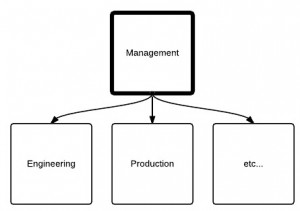
Internally orientated, span of control, steps of hierarchy
Harmon Model
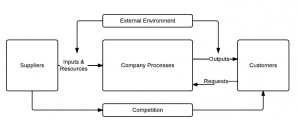
- External forces, much like PESTLE
- The four areas are those which require consideration, including materials, services, people, finance and ideas
- Customers in not only service users but other beneficiaries (ie managers and owners)
- Competitors, those who want access to our market and customers
- Evaluate each sector accordingly
The Organisational View of Business Processes
- How does the organisation react to external environment?
- Consider the core processes
- All businesses = Input -> Processes -> Output
- For an order process it could be:
- Customer Places Order -> Record Order -> Take Payment -> Arrange Delivery – Receives Goods
Porter’s Value Chain
- Google Here (too complex for me to draw!)
- Identifies areas of the business that are performed by an organisation
- Primary Activities – ie creating the product
- Support Activities – Pulling it all together
Value Propositions
Assumes we know our customers and what they want and the interactions, but can be bland descriptions of their value
Important when looking at process improvement (ie it will improve)
Contains:
- Product/Service Attributes
- – Functionality, what the product does
- – Price
- – Quality
- – Choice (bespoke abilities)
- – Availability (how quick to react to customer)
- Image (how the product is seen by the customer)
- – Relationship
- Can differentiate by:
- – Being the most efficient (low cost)
- – Having the best products (high quality and innovation)
- – Providing the best customer service (exceed expectations)
Business Process Models
Includes 5 key points, the tasks (that make up the task), the process flow (activities), the decision points, the actors and the outcome
UML Notation
Swimlane Diagram (Business Process Modelling Notation)
Analysing the Business Process Model
Analysing Handoffs
- Helps with identification of problems with existing processes
- Look at when processes or item is changed between people, queues may form when not syncronised or not enough resource
Piecemeal Modifications
- Some processes may have been in place for a number of years and may have changed slightly to perform the necessary tasks
- Look for problems such as duplication of work, lack of standardisation, inconsistent measurement and control
Improving Business Processes
- Remove the problems and challenge assumptions
Simplify the Process
- Remove un-necessary stages (ie reports being produced that don’t get used)
Consolidate actions
- Remove Bottlenecks
- Make sure capacity is adequate for the task
Change the Sequence of Tasks
- Very often computer-based methods will be an imitation of the clerical tasks
Automate information flow
Redesign the Process
- Identify the triggers for starting and finishing and what needs accomplishing to satisfy the requirements
Redefine Process Boundaries
- What can be done in house or contracted out (ie outsourced payroll)
Process Measurement
Must define how well a process is being done
Internal Measures
- Often derived from organisational objectives, CSFs and KPIs
- Often focuses on what the organisation does as opposed to what the customer wants
External Measures
Concerned with customer expectations, ie:
- Time take to complete a task
- Financial measures such as costs and prices
- Quality measures (accuracy and effectiveness)
Process & Task Measures
- Timeframes for completion of a task or service
- Performance Issues
- Measures and targets need to be selected with care, especially if there are incentives to achieve targets
- What gets measured gets done – sometimes to the detriment of others
SIX SIGMA (DMAIC) Approach
Statistical process control
- Define the problem
- Measure the data
- Analyse the Problems
- Improve the process by looking at root cause
- Control to stop problem occurring
- Gathering the Requirements
The Problems With Requirements
Many errors are introduced in requirements stage as opposed to development stage
Often programmers don’t program the right things
Important because the cost of fixing errors can be vast
Business analyst must help users visualise exact requirements
Typical problems given are:
- Lack of relevance
- Lack of clarity
- Duplication
- Conflicts in requirements
- Difficult to assess if requirements have been achieved
- Assuming of a solution
- Business not identifying requirements
- Inconsistent levels of detail
OSCAR
- Objectives (both business and project objectives)
- Scope (and boundaries of the project)
- Constraints (budget, timescale, quality measures, et al)
- Authority (conflict resolution)
- Resource (available)
A Process for Requirements Engineering
Demands a structured and scientific approach
- Requirements elicitation: gathering information, requirements and needs
- Requirements analysis: looking over overlap and themes
- Requirements validation: sign off the catalogue of requirements
Stakeholders to be involved:
- Business Representative (Project Sponsor) – agree the initialisation document, deliver agreed benefits, fund raising, accept deliverables, rule on conflicting requirements
- Domain Expert – High level advice on requirements, process input, internal or external, be wary of own agenda
- Project Manager – Reports to the project sponsor, creates work packages, management and monitoring and corrective activities
- Business Analyst – Requirements engineering and management
Requirements Elicitation
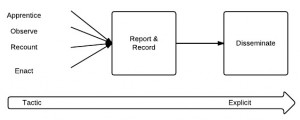
Proactive approach to understanding what is needed
Explicit knowledge (that what an be written down)
Tacit knowledge (that which is difficult to explain)
- Skills (ie how to change gear)
- Taken for granted (terminology, best practice or ‘domain knowledge’)
- Front Story/Back Story (applying ‘spin’)
- Useful to apply observation, shadowing or probing questions ‘how does it work?’, ‘how are problems discovered and rectified?’
- Conceptualising Requirements (lack of expertise may need leading, useful to have a workshop)
- In-depth Understanding – Detailed investigation of issue
- Intuitive Understanding – Brought on through experience and expertise
- Norms of behaviour and communication
- Organisational Culture – The way Management and staff behave
- Communities of Practice – Discrete groups who work by task
Tacit Elicitation Techniques
- Techniques: interviewing, shadowing, workshops, prototyping, scenario, analysis, protocol analysis
Building the Requirements
Building the Requirements List
Business needs log is important here
- Requirement Source Comments- ie reduce widget use A Smith Non-functional, but relevant to requirement 4
Building the Requirements Catalogue
- Helps to raise everything that is important and where it is appropriate
Requirements Analysis
Make sure all the requirements identified have been developed into clear, organised, fully documented requirements for the requirements catalogue
- Categorisation – General, technical, functional and non-functional
- Well defined
- Duplication or Overlap – Allow for merging or refinement
- Unravelling (normalisation) – Only one requirement
- Necessity – Aligned to project and business
- Feasible – Technical, business & financial
- Conflict Resolution – Negotiate a solution with conflict
- Solutions – Not needing addressing
- Quality (SMART)
It should be:
- Clear language
- Concise
- Consistent
- Relevant
- Unambiguous
- Correct
- Testable
- Traceable
Validating Requirements Process/Meeting
- Business sponsor – Confirms alignment and scope
- Business owners – Express the business requirements
- Domain expert – Confirm correct practice
- Developers – Technically feasible
- Testers – Can be tested
- Project management – Correct requirements have been followed
Requirements may be signed off, amendments, or re-done
10 – Documenting & Managing Requirements
Importance of Documentation
- Communication that related activities are consistent
- Gives firm basis for validating the requirements are correct
- Further work will use it as an input
The Requirements Document
Structure of Business Analysis Document
- Introduction & Background – Description of business drivers
- Business Process Models – ‘To be’ state and possible ‘as is’ state descriptions
- Functional Models – ie Context diagrams and Case diagrams
- Data Model – Useful where requirements will build a software product
- Requirements Catalogue – Information about each requirement
- Glossary of Terms – Defines any terms used
- Requirements Catalogue- (Requirement as Requirement Analysis)
- General Requirements & Constraints (Business Constraints – Budgets, timescale, resources, etc, Business Policies – Standards & Business Policy decisions, Legal & Regulatory Constraints, Branding – Image of the organisation (ie style guide), Cultural – ie vision of organisation, Language – ie Globish, Business Continuity – Business policies for reacting to threats, Technical Requirements & Constraints, Hardware – ie makes and models, Software – ie OS, Interoperability – Interfaces required, Internet – Governance of internet and web connectivity, Functional Requirements & Constraints, Data Entry – What data is required, Data Maintenance – How will it handle change, Procedure Requirements – How they will be adopted or changed, Retrieval Requirements – Reports, queries and management information, Non-Functional Requirements, Speed of Performance – How quick does it have to be, Levels of Security – Types of confidentiality and statutory, Access Permissions & Constraints – Definition of stakeholder groups, Backup & Recovery, Archiving & Retention, Maintainability – Servicing, problems investigation & correction, Availability – ie 24/7 or 99.999%, Usability – How easy it is to learn and use, Capacity – How much will it have to contain)
Documenting a Requirement
- Requirement ID – Unique, and easy to cross-reference
- Requirement Name – Short, descriptive phrase
- Requirement Description – Clear definition
- Source – ie Person, group, policy or legislation, the initial source
- Owner – The responsible stakeholder
- Author – Who elicted the requirement
- Type of Requirement – ie general, technical, functional, non-functional
- Priority – MoSCoW (Must have, Should have, Could have, Won’t have)
- Business Area – ie appropriate function or department
- Stakeholders – Those interested
- Associated Non-functional Requirements – ie customer service policy guaranteeing certain responses
- Acceptance Criteria – ie how to know it’s been met
- Related Requirements – ie higher level requirements or related by function, Requirement ID
- Related Documents – Where to find further information, ie meeting minutes
- Comments – Any other useful information
- Rationale – The Business Justification
- Version History – ie reason for changes and Configuration Management
Documentation Philosophy
- Backwards Traceability – Must be traceable to the initial source (ie who identified this?), useful if conflicts arise
- Forwards Traceability – Who dealt with this requirement?
- Configuration Identification (CI) – Can be traced back to the requirement
- Configuration Control – Maintain the changes made to CIs
11 – Modelling Requirements
Modelling System Functions – UML Use Case
Can be easily understood in a workshop setting:
- Actors – People or external systems (stick figures or rectangle with <<word>>)
- Use Case – Represent a function (oval with text)
- System Boundary – Rectangle showing Functions
- Associations – Lines connecting Actors to Use Case
- <<include>> – Connects a Use Case to another Use Case with a dotted arrowed line, implies a Function using another
- <<extend>> – Extends the original Use Case with additional Case
Modelling System Data – Entity Relationship Diagrams
- Attributes (/Data Items) – Entities contain and are described by attributes
- Relationships – 1:m (forked line), 1:1 (straight line), m:m (forked lines)
- Optionality – Dotted line
- Exclusive Relationships – Denoted with parenthesis on line and a letter
Modelling System Data – Class Models
- Account //Class name
- AccountNumber //Attributes
- Name
- CreditLimit
- CreateAccount //Methods
- UpdateCreditLimit
Associations with other classes – 1 — * (1:m), 1..1 — 0…1 (1:0:1), 1..1 — 1..20 (1:1:20)
Generalisation show by arrows between classes
12 – Delivering the Requirements
Could involve:
- Business process change (improvement)
- People changes – Training, redefined, moved, etc
- Changes to organisational structure – Posts may disappear
- Changed to IT systems – Support the business processes
Delivering the Solution Taking Into Account…
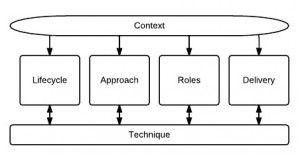
Context
- The external factors (PESTLE, Porter, etc)
- Culture of organisation (inc stakeholders)
- Business context for change
- Constraints on the project
- The priority
- The drivers
Waterfall Lifecycle

- Provides good control from a project management perspective
- Highly structured (which can led to a long drawn out project and not handling of change very well)
V Model Lifecycle
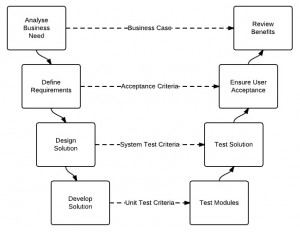
- Allow explicit connections between activities especially testing and analysis
- BA should be involved
Approach
It is necessary to select an approach to carry out the project work
When choosing take into account:
- Context – Corporate standards, complexity, resources etc
- Delivery – ‘Big bang’ delivery or incremental
- Development – Consider analysis, does it need to be done in isolation
Software Development – Unified Process (UP)
Accepts that no single approach fits all organisations at all times
Supports enhancements and small releases
Utilises UML
Software Development – Agile Alliance
- Responds quickly to fast changing business situations
- Difficulty in knowing what is needed early on in the project
- Flexibility in deliverables
- Focus on meeting business needs
Priorities
MoSCoW approach to development and requirements changing priority
Software Package Approach – COTS (Commercial Off The Shelf)
- Cheaper, faster implementation, support and maintenance and updates
- But! Likely won’t be a perfect fit and not likely to provide competitive advantage and may need to change business processes to fit
- May be best to leave the decision to business and knowledge stakeholders
Roles in Delivering Requirements
- Project manager, business analyst, developer and tester
- Involvement will likely change dependant on stage in the lifecycle and which framework is being used
Deliverables
The products that will be delivered will likely vary dependant on the nature of the solution, the organisation and the lifecycle
- Training exercise (so deliverables could be training material)
- Documentation for any process change could be considered a deliverable
13 – Making a Business & Financial Case
The Business Case in the Project lifecycle
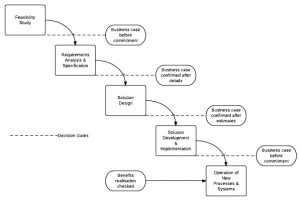
- A business case is a living document and should be revised and revisited
- Should make sure it’s reasons are still valid
- Finance information should be revisited at every stage to make sure they’re still accurate and could be used to measure against the final deliverable
Presentation
- Consider the audience (and corporate standards)
- Keep it succinct and appropriate
- Good structure
- Keep it looking good
- Identifying Options
Explore the various options
- Business Options & Drivers – What the solution will do in terms of business terms
- Technical Options – How the solution will be implemented (ie ICT or business change)
Developing Options
- Identify options – ie through workshops, meetings, industry practice or brainstorming
- Short list options – ie look at cost, complexity, time, etc for 4 options
- Evaluate shortlist – ie a bit more scientifically, evaluated in terms of cost, time and quality or ‘basic’, ‘basic +’ and ‘full’
- Business case – Put available options into business case with calculations
- Always consider ‘do nothing’ is an option and should be documented
Assessing Project Feasibility
- Business – Will the project provide business advantages
- o Strategic fit
- o Market conditions
- o Timeliness
- o Physical infrastructure
- o Organisational ‘fit’
- o Cultural ‘fit’
- o Process compatibility
- o Within competencies
- o Legality, regulators & governance
- Technical – Not specifically ICT
- o Availability
- o Reliability
- o Maintainability
- o Performance
- o Security
- o Scalability
- o Technical skills
- o Compatibility
- o Whether proven
- Financial
- o Within budget
- o Funds available
- o ROI
- o Cash flow
- o Payback
Can also assess feasibility with PESTLE
Or ‘Force Field Analysis’
- Consider inside and outside benefits and score accordingly
Structure of a Business Case
- Introduction – Defines scopes and objectives
- Management Summary / Executive Summary – Detail the whole document succinctly
- Description of Current Situation – ‘As is’, problems and opportunities
- Options Considered – All the shortlist
- Analysis of Costs & Benefits – (see below)
- Impact Assessment – How will it affect the business?
- Risk Assessment – Description, assessment, probability, countermeasures, ownership
- Recommendations – Succinct with timescales (ie GNATT chart)
- Appendices
Analysis of Cost & Benefits
- Tangible Costs – Quantifiable costs ie staff costs, user costs, hardware, infrastructure, software, relocation, training, and ongoing costs
- Intangible Costs – Desruption & recruitment
- Tangible Benefits – Quantifiable, ie staff costs, effort, speed, reductions, inventory,
- Intangible Benefits – Job satisfaction, customer, information, flexibility, marketing, communications
- Avoided Costs (if applicable) – ie Y2K bug
Analysis of Cost & Benefits – Investment Appraisal
DCF, NPV, ROI, Payback all communicate value for money
Benefits Management & Realisation

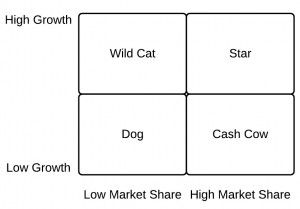
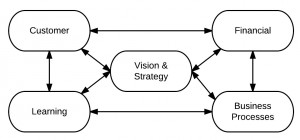
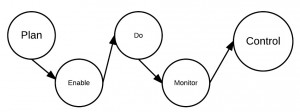
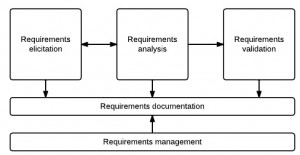

90 Comments
[…] Granted some businesses may struggle pigeon holing their businesses in such a way, but the thought now will pay off in the longer run. See my Business Analysis Notes. […]
Hi,
Many thanks for taking the time to post that. Just about to start studying for that exam on way to BA Diploma in BA….so that is fantastic you’ve posted that help.. thanks so much and good luck with the rest of your exams.. Have bought the BA book as well … just struggling now to find sample exam papers… or is example so simple that this isnt required?
Hi Steve thanks for your comments 🙂
I found that the examples given in the book were close enough to the exam that I needn’t have worried about not being able to find the example exam papers. As I said in my main post if you’re familiar with any other frameworks like in your Diploma you’re working towards you should be fine. I didn’t find the exam too hard going, and if you’re familiar with the book I’ve no doubt you’ll do great.
Gyp
Does anyone know if the BCS exam is the same as the ISEB ones for the BA foundation in Business Analysis?
Thanks
Hi Matt,
I believe it’s one and the same. The ISEB is the BCSs qualification arm after all 🙂
Good luck!
Gyp
Hi Gyp,
Thank you for putting on your study notes. I just passed the exam after using your notes to confirm that i had studied the correct parts of the book!
As you mention the exam is very close to the content in the book.
Thanks,
Fraser
Hi Fraser,
Well done! Glad to hear the notes are still relevant and thanks for letting me know.
Well done again,
Gyp
Hi,
I am planning to take the foundation exam in 2 months time and was looking for sample exam papers. Would any of you be able to help me with the same?
Hi Dias,
Sorry for the tardy response, been hectic! I never managed to find any, but the actual exam wasn’t too different to the questions given in the book.
Good luck I’m sure you’ll be fine!
Gyp
Thanks for the comprehensive set of notes. I am referring these for my preparation. One pointer, SWOT ANALYSIS (BRINGING ALL THE ANALYSIS TOGETHER) image shows the boston box instead.
Aha, very well spotted Ankur! Thanks for letting me know, I’ll update it.
Just goes to show you really know the course!
Gyp
Very well written and quite useful for referring back what i have done… I am just planning to give a shot next week,,, i am just wondering if you could remember some tricky questions you faced.. thanks in advance!!!!
Hi Vaishnavi, glad it’s come in useful for you! I didn’t find any of the question too tricky, the examples given in the text book were very similar to the ones in the exam. Good luck I’m sure you’ll do well 🙂
Just wanted to thank you, I did refer to your notes for a quick recap multiple times. I did pass the exam last week.
Thanks a lot for putting this up.
Well done and congratulations! I’m glad it came in useful for you 🙂 Gyp
Many thanks Gyp.
Great information. It is very meaningful for me.
I’m studying the chapter 3 and I found your information about Boston box.
Many thanks again 🙂
I plan that I will take an exam in July.
Hi Hilen,
I’m glad it’s come in useful for you 🙂 All the best for your exam in July, I’m sure you’ll do great!
Gyp
I’m more self belief when you said that even I know that is one of ten “behavioral skills and personal qualities” (^^).
Gyp, do you have any document which is included question list per chapter ?
Could you please share it to me?
Thank you so much in advanced 🙂
Hi Hien,
I’m pretty sure the book I had as above had example questions for each section, that was all I used 🙂 I’m assuming you have the same book, but as for any mock papers, sorry I don’t have any 🙁
Gyp
Yes, I had the book is same yours.
Any way, thank you so much ^^
Hi gyp, u have a nice summary notes here. You mentioned that there were example questions at the end of each section in the book you recommended. I have the book but cannot find any questions there at all and it’s the same book you gave in the link above.
Is it because its the second edition I have or am I missing something?
Thanks and hope to hear from you ASAP as I have the exam in 1st of August.
Regards.
Hi Steve,
I’m away on business at the moment, but when I get home I will have a look through my book and see what I can do. I’m not sure what version I have, but I did buy it a few years back so it could very well be a different version I suppose.
Leave it with me…
Gyp
Hi Steve,
Sorry about this, but I can’t find my ISEB BA book anywhere. I’ve been through my library and checked at work and can’t find it. I’m guessing I’ve probably lent it to someone.
The exam wasn’t too taxing, and I’m sure if you’re familiar with the concepts and the book you should be more than ok. Good luck!
Gyp
Hi Gyp,
I took the exam a couple of days ago and I passed it. I used your notes as a revise guide and it was very helpful. However I want to point out that it seems that both the book and the exam style have changed recently and based on my experience it is required a lot more detail than the things you note above. Also there are a couple of things you might need to update:
1. The SWOT ANALYSIS still shows the Boston Box
2. I think you should replace the tactic knowledge with tacit knowledge.
Thanks a lot for these notes there were very helpful for me!!
Elisavet
Hi Elisavet
I’m going to appear for the ISEB BA foundation certification in 2 weeks time. I’m using the Business Analysis second edition by debra Paul,donald Yeates and James Cadle. I’m bit worried as you have specified both the book and exam style has changed recently…. any adivse will be helpful, do i need to read through any recent edition of the same book? Has the exam pattern is the multpile choice questions or Scenario type of QA style? Your advice will be helpful to many aspiring candidates.
I appreciate if others can share the information if you have any.
Many thanks,all the best for all who are preparing for this certification.
Kind Regards,
Preedeep
Hi Preedeep,
Best of luck with your exam, I’ll be keeping my fingers crossed for you.
Gyp
Thanks Gyp,I’m hoping Elisavet to give some heads up to me based on her experience 🙂 as she has specified the exam format and book have changed. I think I’m well prepared (Not out of over confidence. Shall keep you all updated soon.
Kind Regards,
Preedeep
Hi Preedeep,
I am planning to take the exam soon. Just wondering how much time did it take to prepare thoroughly?
Regards,
Dona
Hi Preedeep,
Apologies for the late response – I have been a bit crazy the last period. I read the same book with you. What I really meant is that the book has changes since gyp’s notes as the second editions appears to not have any questions. Also, the exam style has changed a bit as I noticed that they focus a lot in details these days. Something they didn’t use to do a few yeas ago based on a friend’s experience. Other than that if you study the book and have a good understanding of the things discussed in it and finally use gyp’s notes for revision you will do fine.
I hope I didn’t come back to you too late. Good luck !!
Elisavet
Hi Elisavet,
Congratulations and well done!
I’m glad my notes came in useful for you, and I suppose I can’t blame the ISEB for updating the exam. Out of curiosity any specific changes you can think of?
I’ve updated the main post, thanks and well done again,
Gyp
Hi,
I took up this exam last friday and passed!.
Thanks for your notes. It helped me a lot while revising on the day before the test. 🙂
It added speed to my revision.
You’re right in saying not to go just by your notes. Lot of questions did appear that were not in your notes.
Thanks
Hi Gg,
Congratulations! Well done.
Glad they came in useful, I’m thinking that the ISEB may have updated the course and the exam.
Thanks and congratulations again,
Gyp
Hi Dona
I spent around 100 hrs doing multiple readings of the suggested book. By the way I manage to pass the certification today, thanks Gyp and everyone for your guidance.
As far as exam is concerned all you need to make sure you understand the techniques/process/models explained on the book.
All the best for anyone taking this certifcation.
Kind Regards,
Preedeep
Congratulations Preedeep 🙂 Well done.
Thanks Gyp.
Ooops just noticed that you already took the exam!! You can ignore my response above. Apologies for the late response again 🙁 and well done!!!
Hey Preedeep,
That’s great news! 🙂 Happy for you and thanks so much for the response! I’ll keep your advice in mind as I study.
Sincerely,
Dona
Best of luck Dona, I’m sure you’ll do great 🙂
Hi,
This is an excellent website with so much information. The effort itself is commendable.
I was planning to take the ISEB BA practitioner exam , by self studying has anyone taken it? Any tips…did anyone pass by self study? what books did you refer to.
Many Thanks.
Hi Ar,
Thanks for the kind words!
Sorry I can’t help you on the practitioner course, only did the foundation one myself. Have you tried asking in a group somewhere like LinkedIn?
Gyp
Indeed excellent notes, I am writing the exam in couple of weeks and have found them really helpful
Have been trying to locate any sample questions, any directions?
Regards,
Gaurav
Hi Gaurav,
Thanks for dropping by and glad they’re helping!
Sorry you’re not the first person to ask and I can’t find any myself.
You could always try getting in touch with the ISEB or after your exam writing some revision questions yourself 🙂
Good luck!
Gyp
Hi all,
i appeared for the certification and cleared it.
the exam questions were sinple derived completely from the reference book business analysis by debra paul
some questions :
1. while understanding CATWOE what
is the analyst supposed to understand first ?
a. Actor
b. World view
c. Owner
d. Customer
2. What precedes Requirement Validation in requirement engineering ?
a. requirement elicitation
b. requirement documentation
c. requirement analysis
d. requirement management
3. An analyst is trying to understand how an system captures an order from customer. which investigation technique is the analyst using ?
a. protocol analysis
b. use case
c. structured obsevation
d. class diagram
4. A company is aiming to access the arrival time of its flights for accuracy. where is this activity performed ?
a. planning activity
b. enable activity
c. monitor activity
d. control acticity
5. What does M stand for in MoSCoW ?
answer is Must have
6. What does Boston matrix consider ?
answer is market share
Hi Mayank,
Congratulations and well done!
Thanks for taking the time to post your experience, I’m sure it’ll really help others!
Thanks again,
Gyp
passed on Sat- thanks for your help- was a good summary of the main points that needed to be covered!
Hi Kemi,
Congratulations! Well done.
Thanks, happy to know the notes came in useful.
Gyp
thanks very much! super useful to recap
Hello,
I find the summary so useful. But My confidence would be boosted if i could have a look at the snippets. Has anybody faced the exam in the recent past.. please do provide your valuable feedback on format and snippets.
Many thanks,
Ranjini
Hi all
I have completed the foundation level through self study and above given notes were great study materials for my exam.
also make sure to fully read and understand (specially all given diagrams) in Debra Paul, Business Analysis book.
Good luck guys !!!
thanks, i passed my exams 82%. i am so glad. I advise everyone to read the book thoroughly, for your knowledge and understanding and to pass as well. the only question i remember now is power/interest grid used in stakeholder analysis. Good Luck
I couldn’t have said it any better myself
Just want to say your article is as surprising. The clearness in your post is just great
and i could assume you are an expert on this subject.
Fine with your permission let me to grab your RSS feed to keep up to date with forthcoming post.
Thanks a million and please continue the enjoyable work.
Many Thanks! Got certified today, your site was very helpful!
Well done and congratulations! 🙂
Hi
I have passed the bcs fondation exam , but i am quite struggling withe the requirement engineering exam , Does anybody have any usefully tips ….how important it is to have bcs diploma to get a decent bcs job in the market.
Hi Megha, well done! Sorry can’t help with the other one I’ve not done it 🙂 Best of luck with your future endeavors I’m sure you’ll do great.
Hello Every one,
I am appearing for ISEB BCS on 21st and honestly I have no idea about it if you guys can help me with dumps by tomorrow I will be great help for me.
Hi Anu. Gosh, you’re leaving it a little late for studying. Assuming you are sitting the BA exam? If so then in your position I’d be trying to learn some of the general themes and sections from the book and hope the rest falls into place from there. Gyp
Hi Everyone
I am appearing for Foundation exam on 18th December. Has anyone recently given this exam, it would be great if exam questions are shared?
A big thanks to Gyp for writing revision notes, really helpful.
Hi Sam,
Good luck! I’m sure you’ll do great. Since my exam was a while ago now I shall see if anyone else wants to offer if they found anything useful for you.
Gyp
Hi Gyp,
Thanks for all this, very useful alongside studying the book. I take my exam on Thursday, do you happen to have any links to any good past papers/sets of sample exam Qs?
Thanks again!
Recently wrote the exam and found these notes quite helpful.
Thank you for sharing this.
Some questions:
1. Ask you to identify what an entity name would be (they list attributes, actions and one entity name)
2. Specify the correct order of CATWOE (WTCAOE)
3. Defintion of a workshop
4. CATWOE link to PESTLE
5. They list a few of the items on Porters model and you need to pick the missing one.
Can’t remember muvh more but will add if i do.
Thank you for coming back to comment Irshad, and thank you for taking the time to write out some suggestions on the exam. I’m sure others will find them very useful 🙂
Gyp
Does anyone have Ecopy of the book “Business analysis” by Debra Paul ? I am planning to give the ISEB BCS foundation examination. It will be a great help to me. The notes are amazing but still I looking for the ebook.
Many thanks in advance.
Hi Guys, planning to take the foundation exam soon. Anyone has any ideas on where to find past examples of questions, also anyone planning to sit the exam soon and wants to discuss preparation I will be interested in chatting with you. Cheers
Hi Dol,
Best of luck 🙂
Gyp
Hi dol,
I am planning to take the exam soon. When are u gonna appear for the exam?
KV
Decided that I was wasting time reading and re reading the book. I used the Gyp notes as a final study guide and passed the exam last Saturday. Thanks Gyp
Now looking for a Training provider for Requirements Engineering & Business Analysis practice, well the rest of the mandatory modules, anyone have any ideas of a fairly priced provider in London? I went to the Metadata offices in London Old street today and they offer a 5 day intensive course on the combined (Requirements Engineering & Business Analysis practice)…. Any ideas anyone? Good to know that its the same book though as I am familiar with it back to front.
Hi Dol,
Well done!
My “go to” training providers of choice are https://www.qa.com and https://www.theknowledgeacademy.com/.
Not entirely sure if they provide the courses though. Or if you felt really keen and wanted to push yourself you could always go and do an MBA 🙂
Gyp
Has anyone done ba oral exam?
Simply put. WOW. A lot of effort has gone into this, thank you.
Would anybody know if the ba book is enough to obtain tge dimploma?
I already have it and would prefer not to have any more ‘bibles’ per, but would do if absolutely required.
Hi Amar,
Glad they’ve come in useful for you! Not sure about the diploma sorry, not done that one 🙂
Good luck!
Gyp
Thank you for sharing ..came across your notes..and great summary to the official book.
I passed my exam this morning ..great help thanks!
Anyone have any ideas for the cheapest way to do the remaining core modules? Any past exams , learning guides?
(Requirements Engineering & Business Analysis practice)….exam only centres?
Regards Nimz
Well done Nimz 🙂 Sorry can’t help more with the remaining modules, I only did the foundation.
Gyp
Hi there, I am planning to self-study for the Foundation exam. Just ordered the book. How many study hours did it take?
Hi Asha,
It was a while ago when I did the course but it took me a week or so to consume the material. But I’ve got a business degree and that helped a great deal!
Best of luck I’m sure you’ll do great!
Gyp
Hi all, I’m sitting the oral exam tomorrow to complete the diploma. It’s a re-sit because I failed in June (one of the most uncomfortable experiences ever) fingers crossed I’m better prepared this Tim around. Thanks for the help Gyp.
Hi Brad,
Best of luck, I know this comment is a little late but sounds like you’ll do well!
Thanks again and always happy to help,
Gyp
Hi,
I’ve got my BA foundation exams tomorrow, found this site very useful. Please do wish me well. Will keep you updated of how it went.
Hi Ola,
Best of luck! I’m sure you’ll do well 🙂 And thanks for commenting, good luck!
Gyp
Hi Gyp,
Thank you for your revised note, it was very helpful. I passed, scoring 35/40.
Thanks,
Ola.
Hi Ola,
Well done 🙂 Congratulations,
Gyp
Still relevant…passed today
Congratulations Ruan! And thanks for taking the time for letting me know,
Gyp
Hi Gyp,
Notes look great, I’m prepping for the oral exam, anyone got any hints or tips for this exam ? Would the notes above be sufficient ?
Thanks in advance
Hi LA,
I’d highly recommend not relying on my notes as your sole source of information on this 🙂
Best of luck!
Gyp
Apologies for the long post, but I hope that these hints and tips are useful!
Preparation for the BCS International Diploma in Business Analysis oral exam
My advice for anyone taking the BCS International Diploma in Business Analysis oral exam would be to get a copy of the syllabus from the BCS website as soon as you plan on taking your exam and paste it into column A of a spread sheet tool. Against each row of the items in the syllabus, write down what your answer would be in the adjacent cell in column B. This will allow you to quickly highlight your areas of weakness if you get stuck and you can consult the BCS Business Analysis book / BABoK / another fellow business analyst as to what the model answer should be. This spread sheet will then act as revision notes to read before the exam.
It is important to remember that some of the oral syllabus covers content not covered by the four written exams that you have taken such as Sectors of the Economy and the Legal and Regulatory Framework for Business Analysis.
There is quite a large reading list mentioned in the BCS International Diploma in Business Analysis oral exam syllabus. I would strongly recommend buying or borrowing a copy of the latest version of the BCS Business Analysis book to revise from and I would say that is difficult to pass the exam without reading this book. That way you will learn all the model answers. I did not read any of the other books mentioned on the reading list and still passed, but that doesn’t mean that it is not a good idea to read them if you can get your hands on them. Any Business Analysis team should have a library of books to use, so why not ask around if anyone has copies of the books or perhaps if your company can buy the books as a learning resource for your team to share?
At the BCS Offices
I sat my BCS International Diploma in Business Analysis oral exam in the BCS office in Southampton Street in London. You can arrive much earlier than your interview slot and there is free tea, coffee and water and also seating. The environment is modern, relaxing and quiet enough to get a seat, a drink and revise any last minute things that you are having doubts about. For these reasons it is probably more advisable to revise in the BCS offices than trying to revise in a nearby noisy coffee shop. You may meet other Business Analysts in the office as they sometimes run more than one oral exam at the same timeslot. There are plenty of places to eat and drink nearby to the London office.
In the BCS International Diploma in Business Analysis oral exam
You will typically be given a brief description of a business and business problem that the business is experiencing to relate many of your answers to. There is no way that you can predict what this will be, but it is typically a business requiring some sort of help to identify and implement an IT solution.
Some questions are far more likely than others to come up in the exam, and often will have follow up questions. As a betting man I would put big money on the following questions being asked:
Q) Name a technique that you can use to analyse the influences on an organisation from the external business environment (e.g. PESTLE and what each letter stands for)
Q) Name two different external factors from your answer above which are relevant to the business problem that the examiners have described (e.g. Technological and Environmental)
Q) Other than interviews and workshops identify an elicitation technique which would be appropriate in the business problem
Q) Why would you choose that particular elicitation technique? What are the advantages and disadvantages?
Q) Name a technique to analyse business perspectives (e.g. CATWOE)
Q) How does the CATWOE technique relate to the Business Activity Model? (e.g. Transformation relates to the Doing activity)
Q) Which document is used to explain the solution options available to the business? (Business Case)
Q) Outline the contents of a Business Case and why each section is important.
Q) Name 3 investment appraisal techniques and rationale for using them (payback period / break even analysis; Discounted cash flow/Net Present Value; Internal Rate of Return)
Q) What are the key parts of the Requirements Engineering process?
Q) What are the contents of a requirements document?
Q) What entries would you find in a requirements catalogue?
The key thing that the examiners are looking for is the ability to describe why you are using a particular technique and explain your reasoning and thought process. Simply explaining what SWOT stands for isn’t going to mean that you pass the exam. You are unlikely to fail because you can’t remember all the elements of Porter’s value chain, but it is important to understand the purpose of Porter’s value chain. The examiners want to hear the BCS model answers so if your company uses different terminology / investment appraisal techniques, ways of working etc. to the BCS, remember to use the BCS terminology and model answers.
I’ve explained all this in the hope that it might give you all a better chance at passing the exam. Good luck!
Just booked the exam for foundation certificate as first step towards diploma completion…. this all work seems very helpful… many thanks for putting this together Andrew uploading it here…
Hi Gyp
Fantastic notes above.
I have an MBA and want to take the BA foundation certificate. How would it help me to get a top job as a business analyst?
Also what is the entry level I can start applying for Jobs.
Hi FCH,
With an MBA and a bit of revision you will be fine to do the foundation certificate.
As for helping, well your masters degree will be at a higher level than the foundation certificate but it will show a specialty on your CV!
Good luck and thanks for commenting,
Gyp